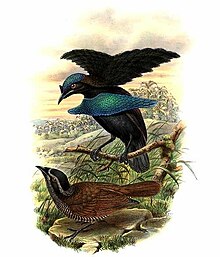Lophorina

| Lophorina | |
|---|---|
 | |
| Lesser lophorina (Lophorina minor) | |
| Scientific classification | |
| Domain: | Eukaryota |
| Kingdom: | Animalia |
| Phylum: | Chordata |
| Class: | Aves |
| Order: | Passeriformes |
| Family: | Paradisaeidae |
| Genus: | Lophorina Vieillot, 1816 |
| Type species | |
| Paradisea superba (Vogelkop lophorina) Pennant, 1781 | |
Lophorina is a genus of birds in the birds-of-paradise family Paradisaeidae that are endemic to New Guinea, formerly containing a single species, but as of 2017, containing three species.
Taxonomy
[edit]The genus Lophorina was introduced in 1816 by the French ornithologist Louis Pierre Vieillot for a single species, Paradisea superba, the Vogelkop lophorina. This is now the type species.[1][2] The genus name combines the Ancient Greek lophos meaning "crest" or "tuft" with rhis, rhinos meaning "nostrils.[3] The genus formerly contained a single species, the superb bird-of-paradise, which had five subspecies.[4][5][6] In 2017 the Swedish ornithologist Martin Irestedt and collaborators suggested that the superb bird-of-paradise should be split into three species. They also proposed a neotype from the Kobowre Mountains in New Guinea for the no longer extant type specimen for Paradisea superba. The original type specimen for superba had been assumed to come from the Bird's Head Peninsula (known as Vogelkop in Dutch and Indonesian).[7] Although, the split was generally supported by other ornithologists, the designation of the neotype and the resulting assignment of subspecies were strongly disputed.[6][8][9][10] The taxonomy adopted here rejects the designation of the neotype but splits the superb bird-of-paradise into three species.[11]
The genus contains three species:[11]
- Vogelkop lophorina, Lophorina superba
- Greater lophorina, Lophorina latipennis
- Lesser lophorina, Lophorina minor
Description
[edit]All members sport a jet-black to black body found only in males, while their female counterparts sport brown upperparts (shade depends on the species) with barred underparts; they have a relatively long to shortish, slender, crow-like bill, and various ornaments. All three species have a distinctive cape found on the nape that they push forward, an iridescent blue-green crown, and an iridescent blue-greenish breast shield that appears to be "smiling" (L. superba) and "frowning" (L. niedda) that the males use to court females. When it comes to the courtship of the female lophorina, males tend to start crouching, showing a repeated display of their breast shield and an exaggerated downward movement to show their crown to the female. During a high intensity display, the male will also fan his nape cape, forming a semi-circle overhead, and around breast shield, all while hopping around the female.[12][13][14] When in full display, the birds look like an otherworldly cartoon character with a fully black face, blue eyes, and blue mouth as they try their best to hop and dance around a potential mate.
See also
[edit]References
[edit]- ^ Vieillot, Louis Pierre (1816). Analyse d'une Nouvelle Ornithologie Élémentaire (in French). Paris: Deterville/self. p. 35.
- ^ Mayr, Ernst; Greenway, James C. Jr, eds. (1962). Check-List of Birds of the World. Vol. 15. Cambridge, Massachusetts: Museum of Comparative Zoology. p. 193.
- ^ Jobling, James A. (2010). The Helm Dictionary of Scientific Bird Names. London: Christopher Helm. p. 230. ISBN 978-1-4081-2501-4.
- ^ Mayr, Ernst; Greenway, James C. Jr, eds. (1962). Check-List of Birds of the World. Vol. 15. Cambridge, Massachusetts: Museum of Comparative Zoology. p. 194.
- ^ Dickinson, E.C.; Christidis, L., eds. (2014). The Howard & Moore Complete Checklist of the Birds of the World. Vol. 2: Passerines (4th ed.). Eastbourne, UK: Aves Press. p. 253. ISBN 978-0-9568611-2-2.
- ^ a b Elliott, A.; Collar, N.J.; Bruce, M.D.; Kirwan, G.M. (2020). "The nomenclature of Lophorina (Aves: Paradisaeidae), with remarks on the type and type locality of L. superba". Zootaxa. 4732 (1): 57–78. doi:10.11646/zootaxa.4732.1.2.
- ^ Irestedt, M.; Batalha-Filho, H.; Ericson, P.G.P.; Christidis, L.; Schodde, R. (2017). "Phylogeny, biogeography and taxonomic consequences in a bird-of-paradise species complex, Lophorina–Ptiloris (Aves: Paradisaeidae)". Zoological Journal of the Linnean Society. 181 (2): 439–470. doi:10.1093/zoolinnean/zlx004.
- ^ Schodde, R.; Christidis, L.; Batalha-Filho, H.; Ericson, P.G.P.; Irestedt, M. (2021). "Why neotypification of Lophorina superba (Pennant, 1781) (Aves: Paradisaeidae) is justified—and necessary". Zootaxa. 4951 (2): 304–320. doi:10.11646/zootaxa.4951.2.5.
- ^ Elliott, A.; Collar, N.J.; Bruce, M.D.; Kirwan, G.M. (2022). "Why the long‐held identity of Paradisea [= Lophorina] superba J.R. Forster, 1781 is correct and should be maintained, with designation of a valid neotype" (PDF). Avian Systematics. 1 (1): 1–16.
- ^ Elliott, A.; Collar, N.J.; Bruce, M.D.; Kirwan, G.M. (2023). "Case 3865 – Proposed conservation of the original and long-established identity of Paradisea superba J.R. Forster, 1781 (currently Lophorina superba; Aves, Paradisaeidae) by setting aside an inappropriate neotype designation". The Bulletin of Zoological Nomenclature. 80 (1): 46–52. doi:10.21805/bzn.v80.a013.
- ^ a b Gill, Frank; Donsker, David; Rasmussen, Pamela, eds. (August 2024). "Crows, mudnesters, melampittas, Ifrit, birds-of-paradise". IOC World Bird List Version 14.2. International Ornithologists' Union. Retrieved 14 September 2024.
- ^ Rimlinger, David; Theule, Jessica; Bass, Kelly (2021). "Breeding history and husbandry of the Superb Bird-of-paradise (Lophorina superba)". Zoo Biology. 40 (5): 485–490. doi:10.1002/zoo.21627. ISSN 0733-3188. PMID 34170023. S2CID 235633854.
- ^ Scholes, Edwin; G. Laman, Timothy (2018). "Distinctive courtship phenotype of the Vogelkop superb bird-of-paradise Lophorina niedda Mayr, 1930 confirms new species status" (PDF). PeerJ. 6: e4621. doi:10.7717/peerj.4621. PMC 5907773. PMID 29682415.
- ^ Theule, Jessica; Rimlinger, David (2022). "Artificial incubation and hand-rearing of Superb Bird-of-paradise (Lophorina superba)". Zoo Biology. 41 (6): 588–594. doi:10.1002/zoo.21685. ISSN 0733-3188. PMID 35098574. S2CID 246429216.







